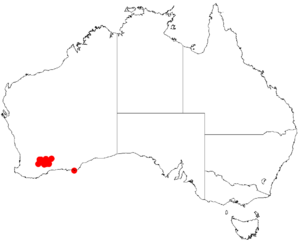Acacia chrysopoda facts for kids
Acacia chrysopoda is a type of shrub that belongs to the Acacia plant family. It is a special plant because it grows naturally only in a specific part of southwestern Australia. This means it is endemic to that area.
Quick facts for kids Acacia chrysopoda |
|
|---|---|
| Scientific classification | |
| Genus: |
Acacia
|
| Species: |
chrysopoda
|
 |
|
| Occurrence data from AVH | |
What Does It Look Like?
This Acacia is a compact, bushy shrub. It usually grows to be about 0.3 to 1.0 metre (1 to 3 ft) tall. Its young branches are covered in golden or white hairs.
Like most Acacia plants, it has phyllodes instead of true leaves. Phyllodes are flattened leaf stems that act like leaves. The phyllodes of Acacia chrysopoda are grey-green. They grow close together at the ends of the branches. They are shaped like thin lines, about 1 to 2 cm (0.39 to 0.79 in) long and 1 to 2 mm (0.039 to 0.079 in) wide. Each phyllode has one to three faint lines running along it.
The shrub blooms in July, showing off yellow flowers. Its flowers grow in simple, round clusters. These clusters appear alone or in pairs where the leaves meet the stem (called the axils). Each flower cluster is about 5 to 6 mm (0.20 to 0.24 in) across. It holds 30 to 45 light golden flowers.
After the flowers, thin, leathery seed pods grow. These pods are long and narrow, but they are also curved and wavy. They measure about 2 to 3.5 cm (0.79 to 1.38 in) long and 3 to 4 mm (0.12 to 0.16 in) wide.
How Was It Named?
Scientists officially named and described this plant in 1928. The botanists Joseph Maiden and William Blakely did this work. They published their findings in a scientific paper.
Later, in 2003, another botanist named Leslie Pedley changed its name. He called it Racosperma chrysopodum. However, in 2006, it was moved back to the Acacia group. So, its official name is once again Acacia chrysopoda.
Where Does It Grow?
Acacia chrysopoda is native to a specific part of Western Australia. You can find it in the Wheatbelt and Goldfields-Esperance regions. It prefers to grow in sandy, clay, or loamy soils that come from granite rock.
This shrub has a limited area where it grows naturally. It stretches from around Karlgarin in the west. It goes as far east as Lake Cronin. You can also find it near Newdegate and Lake King. It usually grows as part of Eucalyptus woodland areas.

